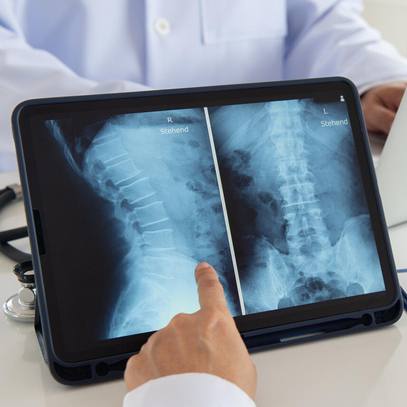-
Education
Science Saturday: A tale of two mentors and a tank full of zebrafish
For Alaa Koleilat, pursuing a doctorate is a tale of two mentors with a few tails thrown in for good measure. With the help of her advisers, and tanks full of zebrafish, she’s taking on hearing loss and finding solutions across the research continuum.
“I love it,” says Koleilat, a student in Mayo Clinic Graduate School of Biomedical Sciences. “I’m trying to develop the skills to work at the lab bench and do experiments and also look at the broader picture and the business side of biomedical science.”

Koleilat chose the clinical and translational science track in the graduate school. The courses are created in collaboration with Mayo Clinic’s Center for Clinical and Translational Science and aim to train students to streamline research “translation,” the process of bringing medical advances to clinical care. Mayo doctoral students in clinical and translational science typically have dual mentors and, now in her fourth year, Koleilat is supported by:
- Stephen Ekker, Ph.D., is a geneticist with an entrepreneurial streak. In his lab he focuses on identifying key genes in organ and blood vessel development. He is director of Mayo Clinic’s Zebrafish Facility and Mayo Clinic’s Office of Entrepreneurship, as well as dean of Mayo Clinic Graduate School of Biomedical Sciences.
- Lisa Schimmenti, M.D., is a physician-scientist. A clinical geneticist, Dr. Schimmenti heads a lab that focuses on congenital hearing loss. She also chairs Mayo’s Department of Clinical Genomics, whose research furthers understanding of genetic-based diseases and helps improve prevention, diagnosis and treatment by tailoring care to each patient’s genetics.
With their expertise and Koleilat's drive, the team is taking on hereditary hearing loss and access to hearing tests.
“Having two mentors has given me a broader insight into various facets of science,” Koleilat says. “Dr. Ekker brings a perspective of science that I never thought about before in terms of biotech, and Dr. Schimmenti has provided me with the aspect of clinical care and what my research means to patients.”
Attuned to Hearing
Koleilat gained an appreciation for hearing at a young age. She developed abnormal speech at age 3 when fluid collected in her ears. Speech therapy erased the abnormality, but she never lost awareness of the effects of impaired hearing. For her master’s degree at the University of Minnesota, Koleilat focused on Usher syndrome, a genetic disorder that is the leading cause of the combination of deafness and blindness. Dr. Schimmenti, then on the university’s faculty, was her mentor. Dr. Ekker served on her thesis committee.
At Mayo Clinic Graduate School of Biomedical Sciences, Koleilat is continuing that research in a way that takes her from the lab to patient care.
“We are focused on making sure our science is translatable to the clinic,” Koleilat says. “We always have patients in mind, even at the lab bench, which gives students big-picture outlooks on their projects. Being reminded of the greater purpose of our work is truly inspiring.”
“We want to empower our future leaders to have professionalism on the medical side and the research side, to leverage and understand both sides,” Dr. Ekker says. Dr. Schimmenti agrees: “We’re helping Alaa find a treatment for the same problem from two different perspectives.”

In her first year of graduate school, Koleilat took the unusual step of choosing a rotation in a clinical department, Otorhinolaryngology (ear, nose and throat), to learn more about how hearing loss affects patients and how it is evaluated and treated.
“Even though it was not basic science, I could see different aspects of hearing loss in patients, and that informed me about the bigger picture of my hearing research at the lab bench,” she says.
At the end of that year, Koleilat joined Dr. Ekker’s zebrafish genetics lab. For her thesis, she chose a pioneering challenge: Identify the first drugs that could restore hearing in Usher syndrome type 1, marked by profound hearing loss or deafness at birth, severe balance problems that delay sitting and walking, and progressive vision loss, usually starting before age 10.
Hearing and Language
The current treatment for hearing loss is hearing aids or a cochlear implant. There is no pharmaceutical treatment for hearing loss, but Koleilat hopes to change that: “No one has asked, ‘Why not take medication every day to preserve hearing?’ We’re trying to do something that no one else has ever done.”
Hearing provides the foundation for children to learn language and speech. A medication that restores hearing, giving youngsters more time to learn communications skills before Usher causes deafness, could produce lifelong improvement in quality of life, Dr. Schimmenti says.
Disrupting Genetic Signals
Researchers have linked Usher syndrome to mutations in at least nine genes. In the inner ear, these genes make proteins involved in the development and function of sensory hair cells, which help to transmit sound and signals to the brain. With Usher syndrome, gene mutations lead to degeneration or loss of these hair cells.

For example, the MYO7A gene makes a protein that plays a role in hair-like projections called stereocilia that line the inner ear. Stereocilia bend in response to sound waves, converting sound waves to nerve impulses that are transmitted to the brain. The bending of stereocilia also help maintain balance and orientation in space. With a mutation of the MYO7A gene, the most common cause of Usher syndrome, the protein doesn’t function properly, preventing hair cells from communicating with the auditory nerve.
Koleilat realized that calcium also plays a role in sending signals in hair cells.
“We believe there’s not enough calcium to get the job done,” she says, “so why not just try to restore the calcium?”
Koleilat chose to focus on medications that stimulate the calcium channel in the hair-cell membrane, which initiates and regulates many intracellular processes, including neurotransmission.
“We want to force it open to allow more calcium ions into the cell,” says Koleilat, who hypothesizes that increased calcium will release more neurotransmitters, increasing the chance that hair cells can send sound-related signals to the brain.
Fishing for Answers
Drs. Ekker and Schimmenti head two zebrafish labs at Mayo Clinic, and much of Koleilat’s research involves the striped Asian minnow. Because their genome is nearly 70 percent identical to humans and they grow quickly, zebrafish are the leading non-mammalian vertebrate model of human development and disease.

Zebrafish have anatomy similar to the human inner ear. Using zebrafish models for Usher syndrome type 1 that exhibit no startle response to sound and swim in a circle due to impaired balance, Koleilat’s team was the first to quantify physiological changes associated with Usher syndrome in zebrafish. Most notably hair cells have fewer neurotransmitter-containing structures on smaller contact sites with neurons.
The team also used zebrafish with the MYO7A mutation to screen potential medications. In testing the concept on zebrafish embryos in medicated water, drugs that boost the hair cell’s intake of calcium offset at least some of the defects that cause deafness.
To accelerate the development process, the team then identified FDA-approved medications with the same action, known as calcium-channel agonists. Although intended for other conditions, the medications have already undergone studies for safety and proper dosing.
“Now it takes 20 years and billions of dollars to develop and test a new pharmaceutical in patients,” Dr. Schimmenti says. “If we find the right off-the-shelf drug, we can resynthesize it to be more efficacious and to have no side effects on other parts of body.”
So far, the team has tested three medications. One produced a startle response to sound and physiological change at the cellular level - an increase in the number of neurotransmitter-containing structures and the size of the contact sites. The same medication also produced significant improvement in swimming behavior.
“It may not be the exact drug to treat hearing loss caused by variants in MYO7A, but it’s paving the way for a new pharmacotherapy,” Koleilat says.
The Student Becomes a Colleague
As Koleilat nears completion of her Ph.D., Drs. Ekker and Schimmenti say their student has become a mature scientist.
“She can think independently, and she is driving the research,” says Dr. Schimmenti, who now thinks of Koleilat as her colleague.
“She’s a really impressive future leader,” says Dr. Ekker, who can envision Koleilat becoming a principal investigator or the CEO of a biotech company.

Koleilat, who plans to seek a postdoctoral fellowship in genetics or genomics, traveled to Germany to present her research at an international symposium on Usher syndrome, where she met and answered questions from patients hoping for the kind of treatment she is trying to develop.
“It was a really profound moment for me,” she says. “Knowing there’s someone out there waiting for this gives more meaning to your work and sparks the flame of motivation. It made me realize that Mayo is training me to be the expert in my field.”
- Jon Holten, July 2019







